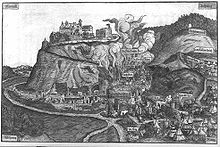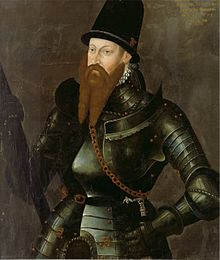Albrecht II. Alcibiades (Brandenburg-Kulmbach)
. Albert II Alcibiades of Brandenburg-Kulmbach (* 28. March 1522 in Ansbach , † 8. January 1557 in Pforzheim ) was Margrave of Brandenburg-Kulmbach from 1541 to 1554. Until his majority his uncle reigned for him George the Pious in the Period from 1527 to 1541.
Life
Origin and name
Albrecht came from the Franconian Hohenzollern family (see also the Hohenzollern family list ). His nickname Alcibiades he was alluding to the Athenian statesman Alcibiades (450-404 BC..), Other epithets were Bellator - the warrior - and the Aechter because it twice with the imperial ban had been occupied. He was the son of Margrave Casimir and his wife, Susanna von Bayern , who was 21 years his junior . Before he died on a campaign against the Hungarians in Ofen , Casimir handed Albrecht into the care of his uncle Georg . His mother Susanna married Count Palatine Ottheinrich . Since she moved to his court, Albrecht remained as heir to the margravate and grew up without parents.
Considerations about his training were limited by the financial resources of the heavily indebted Margraviate, so that this task was left to a tutor at the Plassenburg . Another uncle, Duke Albrecht of Prussia , also tried to help him. In addition, the question of faith played an important role, with Georg prevailing with a Protestant upbringing. Other forces, including Ferdinand I and Charles V, would have liked to see the future ruler as an advocate of Catholicism. Albrecht himself behaved dispassionately in religious matters; his interests are the handling of horses and weapons. He fell into a four-day coma during a drinking bout at which the court master and four other fellow drinkers died .
At the age of 18 Albrecht tried to enforce his claim to power as ruler against his guardian Georg. Georg, who had the long-awaited son and heir with Georg Friedrich in 1539 , tried to postpone the coming of age until he was 24 years old. Nevertheless, Albrecht became Margrave of Brandenburg-Kulmbach in 1541 (as such, he brought his personal physician Seyfferth to Neustadt an der Aisch in 1541 , where Albrecht resided from 1547 and set up the governorate for the Unterland.). As early as 1540 he had become friends with Wilhelm von Grumbach . When Georg finally died in 1543, Albrecht would have admitted to taking over the guardianship of Georg Friedrich and thus Brandenburg-Ansbach ; but he could not prevail against the political resistance, not least of the Ansbach councilors.
Schmalkaldic war and prince uprising


Albrecht placed himself in the service of Emperor Charles V at an early age and thus continued the tradition of the margraves of supporting the Habsburg rulers as followers . In the fight against France under Franz I , Albrecht led 400 of his horsemen. Here he made friends with Duke Moritz of Saxony .
Although a Protestant himself , Albrecht fought in the Schmalkaldic War (1546–1547) as a mercenary and cavalry leader on the side of the Catholic Emperor Charles V. At first he was in the emperor's entourage in his campaign on the Danube. Together with Moritz von Sachsen he then invaded Electoral Saxony under Johann Friedrich I , but was quickly imprisoned in Rochlitz . Until the end of the war he was a prisoner at the Leuchtenburg , most recently in Kahla . The imperial army finally decided the course of the war in the battle of Mühlberg . While Moritz von Sachsen was rewarded with the electoral dignity, the emperor Albrecht remained owed the payments he had made himself. He was rewarded with office and Königsberg Castle .
Albrecht then distanced himself from the emperor and forged secret plans with Elector Moritz von Sachsen that would lead to the prince uprising (1552). It was also possible to win the French King Henry II in the Treaty of Chambord for an alliance. He was assured of the transfer of the Lorraine border bishops of Toul , Metz and Verdun for his support . Albrecht moved into Augsburg with the other princes and camped outside Ulm . The prince uprising succeeded and forced Charles V to flee to Italy. In the Treaty of Passau of 1552 Protestantism was recognized. Albrecht continued his fighting, in the fight against Catholic prince-bishops he tried to expand his influence in Franconia . For a short time, his nearby army strengthened Charles V during the siege of the fortress of Metz , who had declared himself ready to recognize the concessions that Albrecht had made the Bishop of Bamberg and Würzburg. The siege, however, failed and the arrangement did not last. Albrecht held the Duke of Aumale Claude de Lorraine , whom he captured during the siege, imprisoned in the Plassenburg and released him after paying a ransom.
Defeat in the Second Margrave War
The Second Margrave War (1552–1555) developed directly from the prince uprising. Albrechts intentions were in addition to the fight against Catholicism, which by looting and arson was also lucrative high pins enlargement of its sphere of influence in Franconia. He had the idea of a Duchy of Franconia under the rule of the Hohenzollern .
The fighting was initially directed against its immediate neighbors. He besieged the imperial city of Nuremberg and devastated the surrounding area. Despite the unsuccessful siege, he obliged Nuremberg to make high payments. He besieged and occupied Forchheim . He also forced the Hochstifte Würzburg under Melchior Zobel von Giebelstadt and Bamberg under Weigand von Redwitz to make high payments and forced them to cede substantial land to him. However, Emperor Charles V did not recognize these treaties and put Albrecht under imperial ban .
Albrecht also feuded the imperial city of Schweinfurt and the Rhenish elector-archbishops Sebastian von Heusenstamm of Mainz and Johann V. von Isenburg von Trier . Affected were z. B. Mainz , Worms , Oppenheim , Metz , Verdun , Frankfurt or Speyer (see also the history of the city of Speyer ). He demanded a pillage of 150,000 guilders from Speyer Bishop Philipp von Flersheim and, when this was refused, destroyed the Madenburg and Hambach Castle , the ruins of which were to become a German symbol of freedom in 1832.
In 1553 he was defeated in the battle of Sievershausen by a group of German princes, the so-called federal army under Moritz von Sachsen as commander-in-chief, in which the emperor's brother - King Ferdinand I - also participated. Moritz died after the battle as a result of his injuries. Albrecht's homeland in Franconia was devastated, Bayreuth , Hof , Neustadt an der Aisch and Kulmbach went up in flames in 1553 (see Siege of Hof ). The Plassenburg , residence and state fortress of the Franconian Hohenzollern, was besieged until June 1554 and finally handed over and destroyed (see Siege of Kulmbach and the Plassenburg ).
Outlaw and early death
Albrecht, who stayed in Schweinfurt, was ostracized again and the last battle of Schwarzach took place when he left the city in 1554 . He first fled to France and tried to negotiate, which at the end of the Regensburg Reichstag remained unsuccessful. He spent the last years of his young life in Pforzheim with the family of his sister Kunigunde, who was married to Karl II von Baden . After a transitional phase in which it was administered by imperial sequesters , the margrave passed to the Ansbach margrave Georg Friedrich .
literature
- Ernst August Büttner : The war of the Margrave Albrecht Alcibiades in Franconia 1552–1555 , dissertation 1908 at the University of Göttingen, Göttingen 1908; Preview over google books
- Rudolf Friedrichsdorf: Margrave Albrecht Alcibiades as horseman . Berlin 1919.
- Otto Kneitz: Albrecht Alcibiades, Margrave of Kulmbach 1522–1557 . Kulmbach 1951, 2nd edition Kulmbach 1982.
- Otto Kneitz: Albrecht Alcibiades, Margrave of Brandenburg . o. O. 1949.
- Wilhelm Maurenbrecher : Albrecht Alkibiades . In: Allgemeine Deutsche Biographie (ADB). Volume 1, Duncker & Humblot, Leipzig 1875, pp. 252-257.
- Th. Stark: Festschrift 400 anniversary of the Reformation in the Münchberg church district . Court. Pp. 25-27.
- Kurt Stierstorfer: The Siege of Hof 1553 . Hof 2003. ISBN 3-928626-43-4 .
- Johannes Voigt : Margrave Albrecht Alcibiades of Brandenburg-Kulmbach . 2 vol., Berlin 1852.
- Bayreuth margrave booklet . Bayreuth 1910. pp. 31-34. ( PDF download )
- Erich Freiherr von Guttenberg: Albrecht Alkibiades. In: New German Biography (NDB). Volume 1, Duncker & Humblot, Berlin 1953, ISBN 3-428-00182-6 , p. 163 ( digitized version ).
Web links
- Plassenburg at burgenwelt.de
- Portrait of the Margrave Albrecht Alcibiades of Brandenburg-Kulmbach. Painter: unknown. Dated: 16th century. In: History of Bavaria. Exhibition Bavaria Pictures. House of Bavarian History, accessed on March 12, 2013 .
Individual evidence
- ↑ Max Döllner : History of the development of the city of Neustadt an der Aisch until 1933. Ph. CW Schmidt, Neustadt ad Aisch 1950. (New edition 1978 on the occasion of the 150th anniversary of the Ph. CW Schmidt Neustadt an der Aisch 1828–1978. ) P. 67, 107, 196-198 and 524.
- ^ Max Döllner: History of the development of the city of Neustadt an der Aisch until 1933. 1950, pp. 196-206.
| predecessor | Office | successor |
|---|---|---|
|
Casimir Georg |
Margrave of Brandenburg-Kulmbach 1527 / 1541–1554 |
Georg Friedrich the Elder Ä. |
| personal data | |
|---|---|
| SURNAME | Albrecht II Alcibiades |
| ALTERNATIVE NAMES | Albrecht II. Alcibiades of Brandenburg-Kulmbach |
| BRIEF DESCRIPTION | Margrave of Brandenburg-Kulmbach |
| DATE OF BIRTH | March 28, 1522 |
| PLACE OF BIRTH | Ansbach |
| DATE OF DEATH | January 8, 1557 |
| Place of death | Pforzheim |


